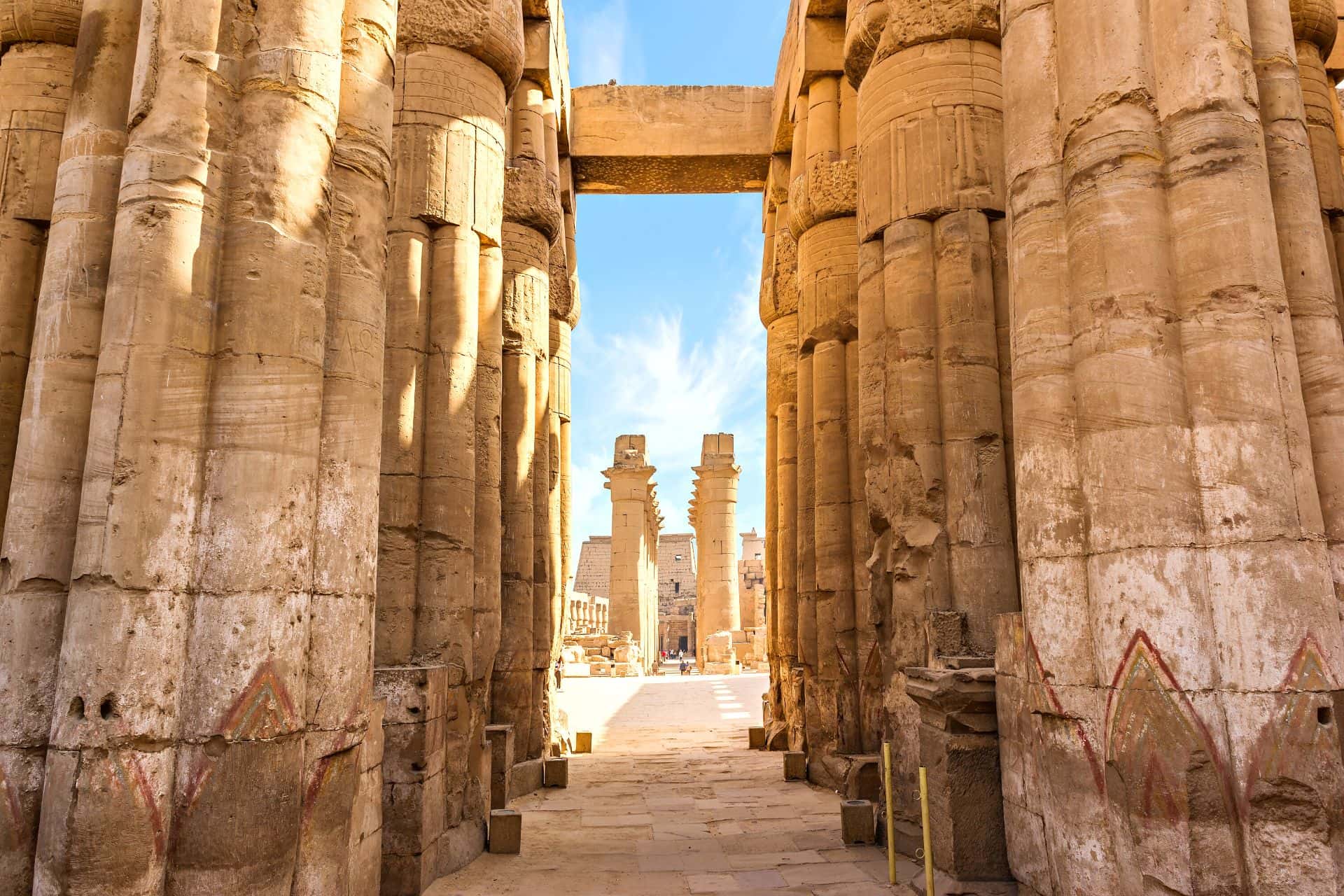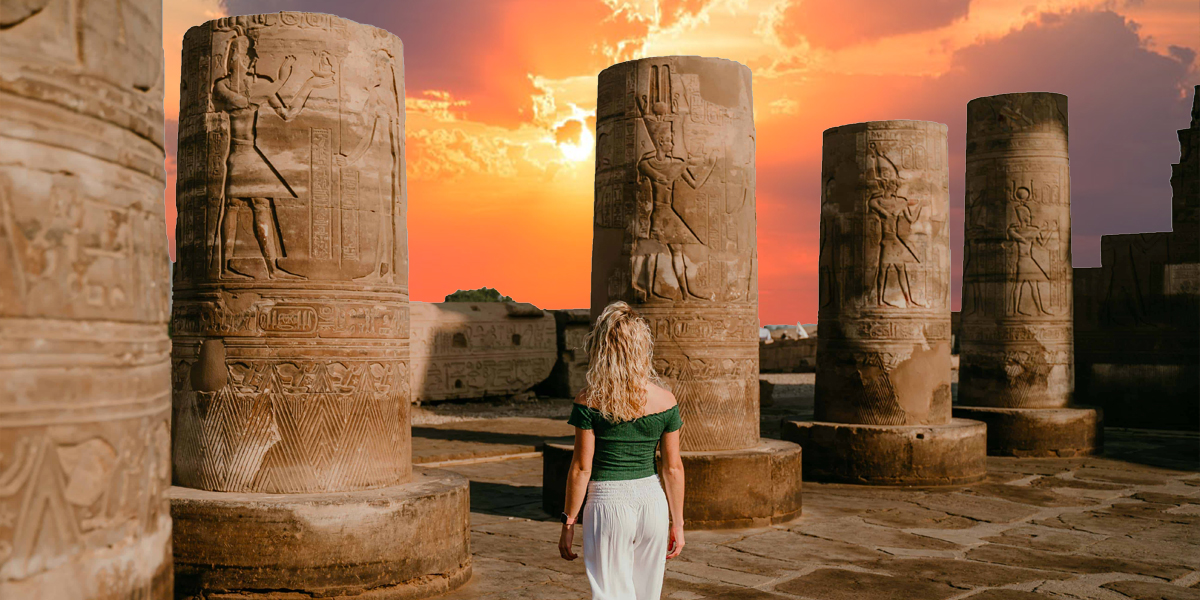A Visit to Luxor Temple: A Must-Do for Any Egyptophile
If you're a history buff or intrigued by ancient civilizations, visiting Luxor Temple in Egypt is an absolute must. Known as the "Temple of Man," it is part of a larger complex on the east bank of the Nile River known as the "Ancient City of Thebes." While the temple has seen its fair share of damage and plundering over the centuries, it remains a stunning and striking example of the grandeur and architectural prowess of the ancient Egyptians. Whether you're a seasoned traveller or embarking on your first trip to Egypt, visiting Luxor Temple will highlight your journey.

Luxor Temple: A Historical Overview
Are you fascinated by ancient civilizations and intrigued by Egyptology? If so, a visit to Luxor Temple is a must-do. This temple is one of the best-preserved ancient monuments in Egypt and is steeped in rich history. Located on the East bank of the Nile River in the city of Luxor, the temple was constructed of sandstone blocks from Nubia and was built during the New Kingdom in 1400 BCE.
The Luxor Temple served many purposes, from being a central location for coronations to an important area for the Feast of Opet. The temple is dedicated to rejuvenating kingship, and many kings may have been crowned here. The Luxor Temple differs from other temples in Egypt because it was not built to honour a specific god. Instead, it is dedicated to Amun Ra, the chief of the Egyptian gods, who acts as the temple’s guardian.
The Luxor Temple spans the reigns of four different Egyptian pharaohs. Amenhotep III, one of Egypt’s great builders, started its construction. Tutankhamun, Horemheb, and Rameses II also had a hand in building the temple. Only two of the original six giant statues of Rameses II remain at the temple. The temple is surrounded by mud-brick walls, which symbolize the separation between the world and the sacred realm of the gods.
A visit to the Luxor Temple is a remarkable experience thanks to its impressive structure and rich history. The temple is one of the biggest open-air museums in Egypt, and it is filled with countless statues, reliefs, and carvings that are still intact to this day. Moreover, the sandstone glows gold at sunset, and temple lights make the monument look even more mysterious and enchanting at night. It is a fascinating experience, even if you are not an archaeologist or a massive Egyptology nerd (like me). I highly recommend visiting the temple in the evening to witness its beauty under the moonlight.
Overall, Luxor Temple is an essential stop on any tour of ancient Egypt. Whether you are a history enthusiast or simply interested in the country’s rich cultural heritage, this temple will be a fascinating and enlightening experience. Don’t miss out on the opportunity to visit one of the best-preserved ancient monuments in Egypt and discover the rich history of the Luxor Temple. [1][2]

Luxor Temple: Significance and Purpose
Visiting Luxor Temple in Egypt is a must-do for any Egyptophile. This prominent historical site along the Nile River is significant as it was a ceremonial place for many Egyptian kings, including Alexander the Great. Built during the New Kingdom, the construction of the Luxor Temple began in 1392 BCE and was completed in 1213 BCE. The temple was primarily utilized during the annual Opet festival, where Amun, Mut, and Khonsu statues were moved from Karnak and reunited at Luxor Temple. It is also considered the "Place of the First Occasion," as God Amun experienced a rebirth during the pharaoh's coronation ceremony.
The kings of Egypt were responsible for constructing the Luxor Temple, with Pharaohs such as Amenhotep III, Tutankhamun, Horemheb, and Rameses II playing significant roles in its completion. The temple was dedicated to the coronation of the new kingship and prominently features statues and carvings of Rameses II. Its architecture is awe-inspiring, with ten sections, including the Mosque Court, Roman Camp, and Birth Chamber. The temple walls were made of mud-brick, symbolizing the separation between reality and the realm of the gods.
The entrance to Luxor Temple is over 200 feet wide and features two obelisks and statues representing the pharaoh sitting on his throne. Colonnades, resembling papyrus, connect the temple's two courtyards with columns depicting the deeds of kings. The inner part of the temple has four antechambers and a sanctuary of the sacred boat. Despite differing heights, the temple's stone obelisks feature the same height, an interesting use of "Optical Illusion" in Egyptian architectural style. The temple has no roof cover and remains imbued with sun rays, highlighting the power of God Amun-Ra.
Luxor Temple is the largest outdoor museum in the world, and its significance lies in its historical and cultural importance as a place of worship and coronation for Egyptian royalty. It remains a site of great awe and reverence, and its construction and architectural features serve as an encyclopedia of the ancient Egyptians' knowledge of humanity and the universe. Plan a visit to Luxor Temple and experience its magnificence for yourself. [3][4]
Luxor Temple: Best Time to Visit and Tips
Are you a true Egyptophile wanting to explore the country's rich history and culture? If so, a visit to Luxor Temple is a must. This stunning temple, located on the East Bank of the River Nile in Luxor, boasts an impressive history dating back to ancient Egypt. As you plan your visit, consider the best time to go and key tips to make your experience the best.
One of the best times to visit Luxor Temple is in the evening. The sandstone takes on a beautiful golden hue as the sun sets, and the temple glows under the moonlight. Be sure to stay until the evening to experience the magic of this incredible site.
When planning your visit, consider booking a tour. A professional guide can provide valuable insights into the history and significance of each temple section. Plus, with a guide, you don't have to worry about getting lost in the vast temple complex.
You should also remember that Luxor Temple is a massive open-air museum, so be prepared to spend significant time exploring. Plan to spend at least a half-day exploring the temple's many wonders.
As you explore, take in the incredible Avenue of Sphinxes. This impressive avenue once stretched to the Karnak Temple and featured rows of human-headed sphinxes. It was used once a year during the Opet festival, an annual celebration in Thebes (Luxor).
Finally, don't forget to wear comfortable shoes and bring plenty of water. The temple complex is large, and you will need to do a significant amount of walking. With these tips in mind, your visit to Luxor Temple will surely be unforgettable.
As a true Egyptophile, visiting Luxor Temple is a definite must. The temple is a testament to Egypt's rich history and culture and a remarkable sight. By considering the best time to go, booking a tour, planning a half-day visit, taking in the Avenue of Sphinxes, and wearing comfortable shoes and bringing plenty of water, your visit to Luxor Temple will be unforgettable. [5][6]

Luxor Temple: A Stunning Sight at Night
Luxor Temple is a must-see attraction for any Egyptophile. Steeped in history, the temple is one of Egypt's most fascinating and well-preserved monuments, with almost all of it still intact. Its majestic beauty is best seen at night when the sandstone glows gold at sunset, and the temple lights make the monument look more mysterious as night settles. The temple's past spans the reigns of four different Egyptian pharaohs, and its purpose was not for worshipping a god or god figure like other Egyptian temples. Instead, it is a dedication to the rejuvenation of kingship, and many kings may have had their crowning at Luxor Temple.
One of the most remarkable sights at Luxor Temple is the giant statues of Ramesses II still standing. Only two of the original six remain, but they are still awe-inspiring. The temple is one of the biggest open-air museums in Egypt, with each section serving a different purpose, from being a coronation area for pharaohs to a shrine for Amun Ra, the chief of the Egyptian gods and the temple's guardian. It played an important role during the annual Opet festivals, where Amun Khonsu and Mut statues were moved from Karnak along the Avenue of Sphinxes.
Visiting Luxor Temple in the evening is highly recommended as the temple is completely lit up and allows visitors until 10 pm. Although it can be quite busy with tour groups, it is a beautiful glimpse into ancient Egyptian royalty and a fascinating experience for any visitor. The sandstone glows gold at sunset, and the temple lights make the monument look even more magical and mysterious. For those interested in history and archaeology, booking a tour of Luxor Temple is essential.
Beyond visiting the temple, there are plenty of things to do in Luxor at night. Karnak Temple Light and Sound Show is a must-see, allowing visitors to walk around different parts of the temple while the show is going on. It's quite eerie to walk around the temple at night and the finale, which takes place opposite the lake, is truly spectacular. A horse and carriage ride along the Corniche is also a relaxing and romantic way to experience Luxor at night.
Luxor Temple is a stunning sight at night and a must-visit for anyone interested in ancient Egyptian history. It exemplifies what the Pharaohs regarded as necessary and played an important role in the annual Opet festivals. With so much to see and do in Luxor at night, it's the perfect addition to any itinerary while visiting Egypt. [7][8]

Luxor Temple: Archaeological Marvels
If you're an Egyptophile, your visit to Egypt is incomplete without a trip to Luxor Temple. Not only is it steeped in history, but it's also one of the most well-preserved ancient sites in Egypt. This temple exemplifies what Pharaohs considered necessary and was essential for the storage of the Feast of Opet, coronations, and royal valuables. Built during the reigns of four different pharaohs, it is a dedication to the rejuvenation of kingship. Unlike other Egyptian temples, Luxor's purpose was not to worship gods but to serve as a coronation area and a shrine for the temple's guardian, Amun-Ra. Luxor Temple is also known as Ipet Resyt, which means "The Southern Sanctuary."
To reach Luxor, there are several modes of transportation available. One way is to cross the Nile River by motor launch or ferry, which costs around 32 cents for foreigners. Another common way is by train, and the Egyptian Railways offers different services, including VIP and Sleeping trains. Luxor also has an international airport with direct flights from 14 cities in eight different countries. Taking a taxi upon arrival is an easy and reasonable option.
Visiting Luxor Temple is a once-in-a-lifetime experience, even if you're not an archaeologist. It is one of the best-preserved of Egypt's ancient monuments and a remarkable sight in person. I recommend visiting in the evening when the sandstone glows gold at sunset, and as night settles, the temple lights make it look more mysterious. Luxor is Egypt's second most visited destination because of its well-preserved attractions and activities to participate in. A tour is necessary for any visitor, even if you're not a massive Egyptology nerd like myself.
A trip to Luxor, Egypt's most extraordinary open-air museum, offers several sights to explore and numerous activities to participate in. It was the capital of ancient Egypt for over 1500 years, making it a beautiful glimpse into ancient Egyptian royalty. Luxor is a holy city where many ancient Egyptians worshipped their gods, and it's home to the crowning and burial of many of its citizens. With its well-preserved attractions and the most significant part of the world's monuments, I guarantee you'll fall head over heels in love with Luxor Temple.
A visit to Luxor Temple is a must-do for any Egyptophile, and this guide makes it easy to plan your visit. You can pick your preferred mode of transportation from different options. Book a tour to enjoy the once-in-a-lifetime experience and explore the remarkable sight in person. Don't forget to visit the temple in the evening to witness its incredible beauty. A trip to Luxor is a beautiful glimpse into ancient Egyptian royalty and culture, with its well-preserved attractions and numerous activities to participate in, making it a unique and unforgettable experience. [9][10]
Luxor Temple: A Must-See for Any Egypt Traveler.
Luxor Temple is a historical landmark that is a must-see for anyone who loves Egyptology or is planning to visit Egypt. As the capital of ancient Egypt for over 1500 years, Luxor City is a beautiful representation of ancient Egyptian royalty, and the temple exemplifies what the Pharaohs regarded as necessary. The temple served many purposes, from being essential for the Feast of Opet to being a place for coronations and even an area to store royal valuables. It is one of the biggest open-air museums in Egypt, making for a remarkable sight in person.
Luxor Temple is one of Egypt's most fascinating attractions and is well-preserved, with almost all of it still intact. Built-in approximately 1400 BCE during the New Kingdom of Egypt, the temple is now a UNESCO World Heritage Site. Luxor Temple's past is exciting and spans the reigns of four Egyptian pharaohs. Amenhotep III commissioned the construction of the temple during his reign, and later Tutankhamun oversaw the construction, then Horemheb and finally Rameses II. The Luxor Temple deity is Amun Ra, the chief of the Egyptian gods who act as the temple's guardian. Each section of the temple served a different purpose, like being a coronation area for Pharaohs or a shrine for Amun.
Aside from being a fascinating experience, even if you're not an archaeologist or an Egyptology nerd, visiting Luxor Temple should be on your must-do list when visiting Egypt. I recommend visiting the temple in the evening, as the sandstone glows gold at sunset, and as night settles, the moonlight and temple lights make the monument look more mysterious. The temple is one of the best-preserved of Egypt's ancient monuments and is a dedication to the rejuvenation of kingship. You'll be amazed by the craftsmanship and intricate carvings on the walls. Only two of the original six giant statues of Ramesses II remain at the temple, but it's still awe-inspiring.
When planning your visit to Luxor Temple, booking a tour is a superb option. And, if you're short on time or want to visit multiple locations in Luxor, consider creating an itinerary for your trip. The East Bank of Luxor is the location of Luxor town, where most Egyptians live and work. It is also where you'll find the majority of hotels and restaurants. The West Bank of Luxor is where the ancient Egyptians buried the dead. Each night, the sun sets on the West Bank, so this becomes the necropolis, the area that is filled with tombs and mortuary temples, including the famous Valley of the Kings.
Luxor Temple is a must-see for any Egypt traveller. It holds significant history and is a beautiful glimpse into the ancient Egyptian culture of royalty. Whether you're an Egyptology nerd or just on a casual vacation, you'll be hard-pressed to find a more impressive and well-preserved monument than Luxor Temple. With all of its mysteries and secrets, Luxor Temple will leave a lasting impression on any visitor. [11][12]
